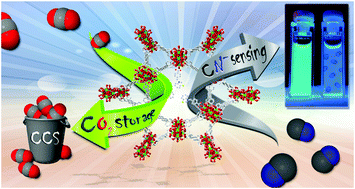Benzothiazolium-functionalized NU-1000: a versatile material for carbon dioxide adsorption and cyanide luminescence sensing†
Abstract
A tailor-made benzothiazolium bromide salt functionality (BzTz) is introduced via solvent-assisted ligand incorporation (SALI) into the mesoporous Zr-based metal–organic framework NU-1000. The resulting NU-1000-BzTz composite has been thoroughly characterized in the solid state. The functional group loading has been determined through 1H NMR analysis of the digested sample (5% HF-DMSO-d6): a maximum value of 1.7 BzTz ligand per [Zr6] node is achieved. The material preserves its pristine crystallinity after SALI, as witnessed by powder X-ray diffraction. The functionalized MOF has a slightly lower thermal stability than its parent material (Tdec = 780 vs. 800 K, respectively). The N2 adsorption isotherm collected at 77 K disclosed that its BET specific surface area (1530 m2 g−1) is lower than that of prisitine NU-1000 (2140 m2 g−1), because of the space taken and weight added by the dangling benzothiazolium groups inside the pores. A total CO2 uptake of 2.0 mmol g−1 (8.7 wt% CO2) has been calculated from the CO2 adsoprtion isotherm collected at T = 298 K and pCO2 = 1 bar. Despite the lower BET area, NU-1000-BzTz shows an increased thermodynamic affinity for CO2 (isosteric heat of adsorption Qst = 25 kJ mol−1) if compared with NU-1000 (Qst = 17 kJ mol−1), confirming that the presence of a polar functional group in the MOF pores improves the interaction with carbon dioxide. Finally, NU-1000-BzTz has been exploited as a luminescent sensor for polluting anions (CN−, SCN−, OCN−, and SeCN− as sodium or potassium salts) in aqueous solutions, after bromide exchange. A marked reversible blue shift of its emission band from 490 to 450 nm is observed in all cases, with the associated emission color change from light green to blue under a UV lamp. The detection limit of CN− (1.08 × 10−6 M) is much lower than that measured for the other “stick-like” anions considered in this study. The process occurs efficiently even in the presence of other competing ions (i.e. in ordinary tap water), opening promising application perspectives in cyanide luminescence sensing in drinking water.



 Please wait while we load your content...
Please wait while we load your content...